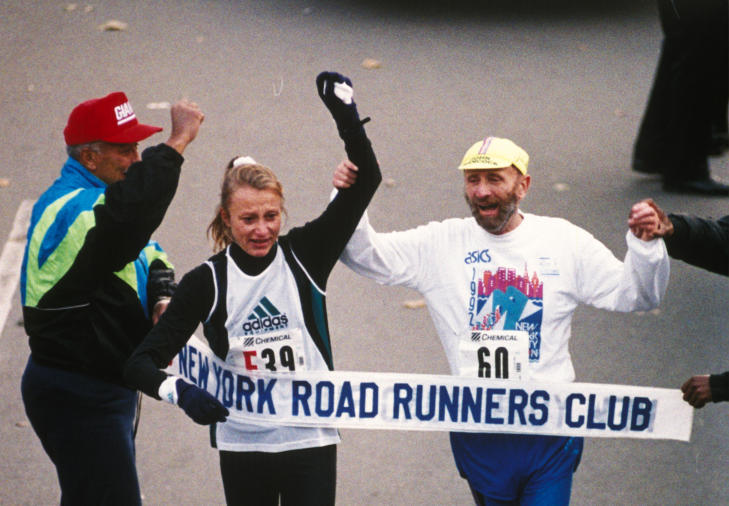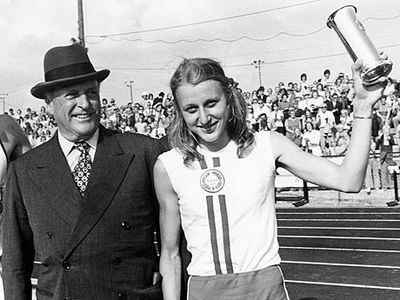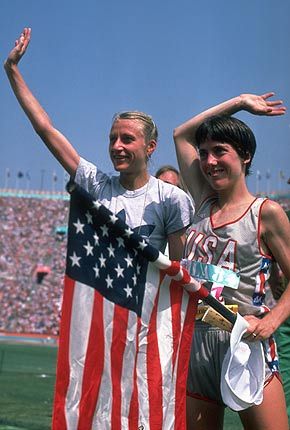 |
| Grete Waitz crosses the finish line at the 1992 New York marathon in company of race director Fred Lebow Photo: AFP/ Scanpix http://www.dagbladet.no/2011/04/19/sport/grete_waitz/friidrett/16245666/ |
Grete Waitz’s tough running personality had been moulded during her winter workouts at the wild Norwegian lands. While most athletes just abandoned training as the snow started to cover the fields, leaving on their own the practitioners of cross-country skiing, Grete enjoyed challenging the wind and the rain. She would instead take holidays as the days would become sunny and warm; too easy for her. Being a full time teacher in a secondary school, she would need to wake up for her runs at 5 o’clock, long before the Northern dawn. Then, during the day, she would attend her courses in PE, Norwegian and English and as the light had again failed she would be picked by her accountant husband Jack for her evening training. This one would consist in repeated charges to steep snow-swept hills, seeing no more than a stride or two ahead, her breath snapping in the 10-below zero air. (1) Jack Nilsen was always a really supportive partner, giving company Grete in her hard workouts in the country and discussing with her programs and tactics.
Grete Waitz had been the heir of a fecund tradition of distance running at the rigorous Scandinavian lands, mainly in Finland and Sweden
Women athletes were also struggling to be accepted in track and field competitions at the same level than their male counterparts. At 1972 Munich Olympics, when Grete competed for the first time at the Games as she was 18 years old, only 14 female events were contested, against 24 in the men’s side. Especially women who excelled in long distances were clearly discriminated, being the longest held event the 1500 metres. Delicate girls were not supposed to be able of enduring too many miles and were not accepted either in classic marathons. Doris Brown Heritage, who was a five time World Cross Country champion as Grete, between 1967 and 1971, was one of many women whose talent was wasted: she was forced to run the 800 metres distance at Mexico Olympics, when she was a potential marathon runner. It is also worth mentioning the amazing story of American pioneer Kathrine Switzer, who challenged the all-male tradition in 1967 Boston marathon, getting a number entry, after misleading the organisers by registering with her initials (K. V. Switzer). Boston official Jock Semple tried to remove her form the race physically, but the competitors helped Switzer out so she could reach the finish line. Eventually she was suspended by her national athletics federation, after being found guilty of up to four different infractions. (2)
 |
| Grete Waitz in her younger athletic years http://mujeres-riot.webcindario.com/Grete_Waitz.htm |
Grete Waitz, who had entered athletics, inspired by neighbour javelin phenomenon Terje Pedersen, had started with the sprints but quickly moved to longer distances, feeling she was growing stronger but not faster. By the time she was in her twenties the longest Olympic available events did not suffice her anymore. She achieved a bronze medal at the 1500 metres at the 1974 European Championships and another one at the 3000 specialty four years later, noting she had endurance but lacked a kick which could match the ones of stars Lyudmila Bragina, Gunhild Hoffmeister, Tatyana Kazankina or Svetlana Ulmasova. At the Montreal Olympics she could not go further than the semi-finals and, despite breaking twice the world record at the 3000 metres , she was about to quit sport and only her husband encouragement made her continue. Then she won her first major title at the 1977 World Cup in Düsseldorf, beating for the first time at this level Lyudmila Bragina, who would retire soon afterwards, and also came her five victories at the World Cross Country, beginning in 1978. At the only long distance global championship women were allowed, Grete got revenge of Kazankina, Ulmasova or Marasescu. Only Romanian Maricica Puica, who became in Los Angeles 3000 metres Olympic champion, could beat her in natural environment at the 1982 and 1984 editions. By then Grete Waitz had also become an outstanding marathon specialist.
Prior to her marathon debut, Grete Waitz had run the1500 metres in 4:00.55, the 3000 in 8.31.8 (the second best mark at the time) and the 10 kilometres on the road in 31:15.4 (a world record which some years later would improve further to 30.59). With such credentials, which still sound stunning 30 years later, that 25-year-old jewel nowadays would have quickly moved to the marathon. Yet back in 1978 things were not as simple. New York Boston and Fukuoka Boston New York City
 |
| Some of the female entries at the 1972 Boston marathon, the first time women were allowed in the race http://blogs.diariovasco.com/airelibre/ |
Prior to her marathon debut, Grete Waitz had run the
Grete had never run straight that distance in her life, not even in training. She had not even tried a half-marathon and was really hard to be persuaded. Her husband Jack and former track champion Knut Kvalheim got her on the plane to the Big Apple race. She was given the anonymous number 1173F and was supposed to act just as a pacemaker. (3) Grete had not endeavoured her workouts to specific marathon preparation and travelled mainly to visit the town in what was called a second honey moon. In the race, the debutant trailed cautiously German Christa Vahlensieck, the then record holder with 2:34:48, not launching her attack until 10 miles to go. Eventually, Grete crossed the line first, improving the world best in more than 2 minutes (2:32:30). Yet she finished exhausted and half-injured. Indeed, she reacted furiously against Jack: “I’ll never, never do this again.” She could not run in several days; hardly walk. (4)
However, afterwards she realised her performance in New York New York 1988, a record in both sex categories, unlikely to be beaten in many decades. In 1979 she would smash again her world record to 2:27:32, being the first woman under 2:30, and the following year she would complete the race in 2:25:41. In three years she had lowered the women’s best in no less than nine minutes, breaking all topics about female limitations and proving they could be as competitive as men. Finally, her long experience in the track in middle distances had allowed her to acquire speed endurance enough to destroy all road records. Grete also shone in London, another young marathon, winning the 1983 and 1986 editions, the former with her fourth world record (2:25:29) and the latter in her all-time PB (2:24:54).
Grete Waitz arrival in the American roads was contemporary to the big boom the marathon experienced in the late 70s and 80s. People all around the world started to practise massively jogging or fartlek, for healthy reasons or simple pleasure. Besides women were not anymore ignored by organisers and the media but began to receive identical support than the men they were now running alongside by thousands. (5) Grete contributed decisively to some of these things. (6) She became the face of the Race of the Five Boroughs, which passed from local curiosity to global cultural phenomenon. (7) Just 55 people had completed the race in 1970. In 2010 the number increased to 45.000. On the other hand, in 1978, the year of Grete’s debut, only 8.9% of the finishers were female. In 1988 as she won her ninth and last title the figure had grown up to 18% . In 2010, female made up nearly the 36% of the field. (8) In words of the current responsible of the race, Mary Wittenberg, all the little girls in New York wanted to be like Grete, who never had children but enjoyed to be surrounded by hundreds of them in Central Park. She opened the doors for every upcoming marathon woman and every one recognised the big influence she had had in her, starting by her contemporaries Olympic champions Joan Benoit and Rosa Mota and her compatriot Ingrid Kristiansen. Her archrival and friend Benoit would call her wisely “the Queen of Hearts”. Paula Radcliffe would even ape her trademark pigtails. In 1985 her heir Kristiansen would become the new record holder with an unbelievable 2:21:06 in London , only 15 seconds better than Benoit in Chicago
 |
| Joan Benoit and Grete Waitz celebrate together after the 1984 marathon Olympic final http://mujeres-riot.webcindario.com/Grete_Waitz.htm |
Grete Waitz’s performances also influenced decisively the incorporation of the female marathon event in the Olympic roster. The Norwegian became the first World champion in Helsinki
We can see many different kinds of behaviour on an athletics track, depending on the athlete. There is Yelena Isinbayeva who relax reading a book on her own, waiting patiently for her rivals to reach the heights where she usually begins her competition; but there is, also at the Pole Vault, Pawel Wojciechowski who was clapping his hands to cheer Lázaro Borges, as the Cuban was trying to jump 5.95 in order to beat him in Daegu Worlds. Then to lose a competition is not easy to be accepted sometimes: Carl Lewis left the stadium frustrated, after being defeated at 1991 Tokyo Worlds by Mike Powell, who also broke the legendary’s Bob Beamon record in the process. He also had the option of celebrating with his compatriot the best long jump competition ever. Haile Gebrselassie and Paul Tergat always did so, despite belonging to different countries.
Grete Waitz was not as outgoing and expressive as Haile but her interaction with her rivals was similar to the Ethiopian champion’s way. As she was defeated, Grete congratulated effusively Joan Benoit and both were seen sitting together at the stadium the following day. They shared a lifelong friendship and the same kind of relationship and encouragement was established with the upcoming Portuguese star Rosa Mota. When Grete Waitz started to open herself to the other athletes, journalists and officials, everybody could find out how humble, warm, generous and even funny that woman was. She was really the role model for everybody and not only because of her victories. In words of Amby Burfoot she “gave and gave and gave and asked nothing in return.” (10) After retiring, Grete became one of the most known ambassadors for the sport and was also in charge of many charity initiatives. She ran for the last time the New York Boston 42,195 km distance, recalled a gust of wind which helped her late in the race: “It gave me a big push when I most needed it. Looking back on it now, I think it must have been Grete saying: ‘keep it going Joanie, not just today but for life itself.’ ”(11).








